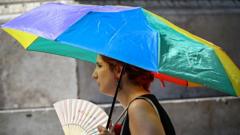As an intense heatwave continues to plague Southern Europe, fierce wildfires erupt in Spain and France, leading to injuries and significant damage to land. Authorities impose restrictions to protect citizens amidst soaring temperatures.
Europe Faces Devastating Wildfires Amid Intense Heat Wave

Europe Faces Devastating Wildfires Amid Intense Heat Wave
Countries in Southern Europe struggle with severe wildfires after a prolonged heatwave, with Spain and France suffering the most as firefighting efforts intensify.
In Southern Europe, rampant wildfires are wreaking havoc in Spain and France as a prolonged heatwave transforms landscapes into fire hazards. On Tuesday, flames are roaring across several regions, with increased emergency alerts as conditions remain unfavorable for containment.
In France, as firefighters tackle a large blaze near Narbonne, local authorities report injuries to five individuals, including firefighters. The Narbonne fire, burning for over two days, has ravaged close to 5,000 acres, prompting over 1,000 firefighters to join the battle against the flames, with diminishing success due to high winds and dry conditions.
Spain has initiated emergency protocols, with local officials in Catalonia ordering residents to stay indoors as firefighters struggle to control a blaze that has consumed nearly 6,000 acres. Wind gusts reaching speeds of 55 miles per hour are further complicating firefighting efforts, according to regional fire inspectors.
Last week, Europe sweltered in unprecedented heat, with countries like Spain and France seeing the worst impacts. Experts describe the combination of extreme temperatures, drought, and extensive growth of flammable plant species, such as eucalyptus, as a "perfect storm" for wildfires.
Despite some recent cooling in parts of France, dangerous wind patterns continue to pose a risk as they exacerbate fire spread. Additionally, temperatures are predicted to soar in other European nations. Romania has issued a red warning, predicting temperatures may rise to 41°C (105.8°F), while Serbia anticipates similar dangerous conditions.
In Greece, authorities are imposing strict measures in response to soaring temperatures, surpassing 40°C (104°F). Business operations are being restricted, especially at high-risk hours, to protect local workers. Popular tourist sites, like the Acropolis, are limiting visitor hours to safeguard against heat-related risks.
The ongoing heat crisis highlights the urgent need for effective climate and safety measures as Europe grapples with the consequences of extreme weather.
In France, as firefighters tackle a large blaze near Narbonne, local authorities report injuries to five individuals, including firefighters. The Narbonne fire, burning for over two days, has ravaged close to 5,000 acres, prompting over 1,000 firefighters to join the battle against the flames, with diminishing success due to high winds and dry conditions.
Spain has initiated emergency protocols, with local officials in Catalonia ordering residents to stay indoors as firefighters struggle to control a blaze that has consumed nearly 6,000 acres. Wind gusts reaching speeds of 55 miles per hour are further complicating firefighting efforts, according to regional fire inspectors.
Last week, Europe sweltered in unprecedented heat, with countries like Spain and France seeing the worst impacts. Experts describe the combination of extreme temperatures, drought, and extensive growth of flammable plant species, such as eucalyptus, as a "perfect storm" for wildfires.
Despite some recent cooling in parts of France, dangerous wind patterns continue to pose a risk as they exacerbate fire spread. Additionally, temperatures are predicted to soar in other European nations. Romania has issued a red warning, predicting temperatures may rise to 41°C (105.8°F), while Serbia anticipates similar dangerous conditions.
In Greece, authorities are imposing strict measures in response to soaring temperatures, surpassing 40°C (104°F). Business operations are being restricted, especially at high-risk hours, to protect local workers. Popular tourist sites, like the Acropolis, are limiting visitor hours to safeguard against heat-related risks.
The ongoing heat crisis highlights the urgent need for effective climate and safety measures as Europe grapples with the consequences of extreme weather.























